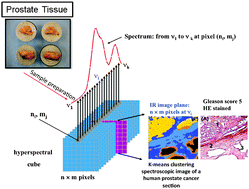Prostate cancer has become one of the most common malignancies worldwide. Morphological and histomorphological evaluation of this disease is a well established technique for the cancer classification and has remained relatively unchanged since several decades, although it remains a time consuming and subjective technique, with unsatisfactory levels of inter- and intra-observer discrepancy. Novel approaches for histological recognition are necessary to identify and to investigate cancer in detail. Fourier transform infrared (FTIR) spectroscopic imaging has become an essential tool for the detection, identification and characterization of the molecular components of biological processes, such as those responsible for the dynamic properties of cancer progression. Major advantage of this new technique is the acquisition of local molecular expression profiles while maintaining the topographic integrity of the tissue and avoiding time-consuming extraction, purification and separation steps. By using this method it is possible to investigate the spatial distribution of proteins, lipids, carbohydrates, cholesterols, nucleic acids, phospholipids and small molecules within biological systems by in situ analysis of tissue sections. We applied this technique on prostate cancer patients radical prostatectomy specimens in order to develop new tools for histomorphological analysis and the characterization of snap frozen prostate cancer tissues. As a first step, an optimization of sample preparation, tissue section thickness and IR slide material was performed. Special preparation methods for FTIR imaging are the essential requirements to maintain the spatial arrangement of compounds and avoid delocalization and degradation of the analytes. Subsequently, selected cancer samples were characterized with the prior optimized parameters and analyzed by univariate and cluster analysis. For the interpretation and calibration of the system we correlated the FTIR-images with the histopathological information. With this method it is possible to distinguish between cancer and noncancer areas within a prostate cancer tissue with a resolution of 6.25 μm × 6.25 μm on frozen sections.

You have access to this article
 Please wait while we load your content...
Something went wrong. Try again?
Please wait while we load your content...
Something went wrong. Try again?


 Please wait while we load your content...
Please wait while we load your content...